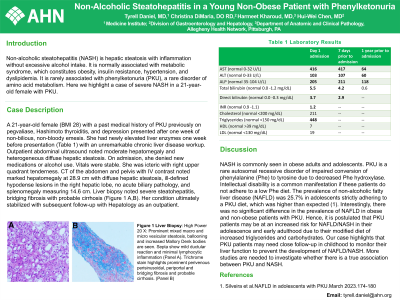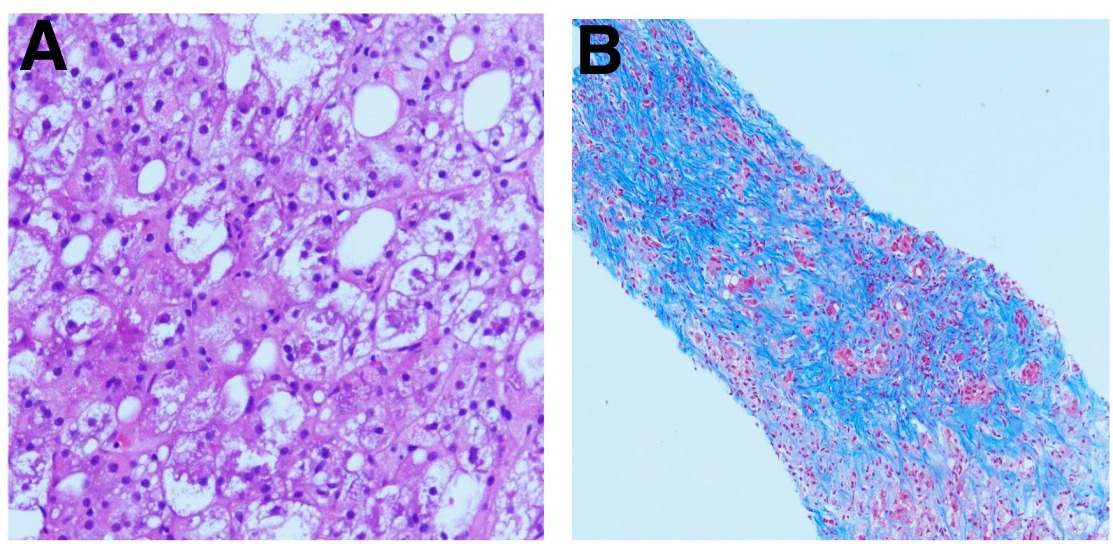Tuesday Poster Session
Category: Liver
P3961 - Non-Alcoholic Steatohepatitis in a Young Non-Obese Patient With Phenylketonuria
Tuesday, October 24, 2023
10:30 AM - 4:00 PM PT
Location: Exhibit Hall

Has Audio

Tyrell Daniel, MD
Allegheny General Hospital
Pittsburgh, PA
Presenting Author(s)
Tyrell Daniel, MD1, Christina DiMaria, DO, RD2, Harmeet Kharoud, MD2, Hui-Wei Chen, MD2
1Allegheny General Hospital, Pittsburgh, PA; 2Allegheny Health Network, Pittsburgh, PA
Introduction: Non-alcoholic steatohepatitis (NASH) is hepatic steatosis with inflammation in absence of excessive alcohol intake. It is normally associated with metabolic syndrome which constitutes obesity, insulin resistance, hypertension, and dyslipidemia. It is rarely associated with phenylketonuria (PKU), a rare disorder of amino acid metabolism. Here we highlight a case of severe NASH in a 21-year-old female with PKU.
Case Description/Methods: A 21-year-old female (BMI 28) with a past medical history of PKU previously on pegvaliase, Hashimoto thyroiditis, and depression presented after one-week of non-bilious non-bloody emesis. She had newly elevated liver enzymes one week prior to presentation (Table 1) with an unremarkable chronic liver disease workup. Outpatient abdominal ultrasound noted moderate hepatomegaly and heterogenous diffuse hepatic steatosis. On admission, she denied any new medications or alcohol use. Vitals were stable. She was icteric with right upper quadrant tenderness. CT of the abdomen and pelvis with IV contrast noted marked hepatomegaly at 28.9 cm with diffuse hepatic steatosis, ill-defined hypodense lesions in the right hepatic lobe, no acute biliary pathology, and splenomegaly measuring 14.6 cm. Liver biopsy noted severe steatohepatitis, bridging fibrosis with probable cirrhosis (Figure 1 A,B). Her condition ultimately stabilized with subsequent follow up with Hepatology as an outpatient.
Discussion: NASH is commonly seen in obese adults and adolescents. PKU is a rare autosomal recessive disorder of impaired conversion of phenylalanine (Phe) to tyrosine due to decreased Phe hydroxylase. Intellectual disability is a common manifestation if these patients do not adhere to a low Phe diet. The prevalence of non-alcoholic fatty liver disease (NAFLD) was found to be 25.7% in adolescents strictly adhering to a PKU diet which was higher than expected (1). Interestingly, there was no significant difference in the prevalence of NAFLD in obese and non-obese patients with PKU. Hence, it is postulated that PKU patients may be at an increased risk for NAFLD/NASH in their adolescence and early adulthood due to their modified diet of increased triglycerides and carbohydrates. Our case highlights that PKU patients may need close follow-up in their childhood to monitor their liver function to prevent development of NAFLD/NASH. More studies are needed to investigate whether there is a true association between PKU and NASH.
Reference
1. Silveira et al.NAFLD in adolescents with PKU.March 2023.174-180

Disclosures:
Tyrell Daniel, MD1, Christina DiMaria, DO, RD2, Harmeet Kharoud, MD2, Hui-Wei Chen, MD2. P3961 - Non-Alcoholic Steatohepatitis in a Young Non-Obese Patient With Phenylketonuria, ACG 2023 Annual Scientific Meeting Abstracts. Vancouver, BC, Canada: American College of Gastroenterology.
1Allegheny General Hospital, Pittsburgh, PA; 2Allegheny Health Network, Pittsburgh, PA
Introduction: Non-alcoholic steatohepatitis (NASH) is hepatic steatosis with inflammation in absence of excessive alcohol intake. It is normally associated with metabolic syndrome which constitutes obesity, insulin resistance, hypertension, and dyslipidemia. It is rarely associated with phenylketonuria (PKU), a rare disorder of amino acid metabolism. Here we highlight a case of severe NASH in a 21-year-old female with PKU.
Case Description/Methods: A 21-year-old female (BMI 28) with a past medical history of PKU previously on pegvaliase, Hashimoto thyroiditis, and depression presented after one-week of non-bilious non-bloody emesis. She had newly elevated liver enzymes one week prior to presentation (Table 1) with an unremarkable chronic liver disease workup. Outpatient abdominal ultrasound noted moderate hepatomegaly and heterogenous diffuse hepatic steatosis. On admission, she denied any new medications or alcohol use. Vitals were stable. She was icteric with right upper quadrant tenderness. CT of the abdomen and pelvis with IV contrast noted marked hepatomegaly at 28.9 cm with diffuse hepatic steatosis, ill-defined hypodense lesions in the right hepatic lobe, no acute biliary pathology, and splenomegaly measuring 14.6 cm. Liver biopsy noted severe steatohepatitis, bridging fibrosis with probable cirrhosis (Figure 1 A,B). Her condition ultimately stabilized with subsequent follow up with Hepatology as an outpatient.
Discussion: NASH is commonly seen in obese adults and adolescents. PKU is a rare autosomal recessive disorder of impaired conversion of phenylalanine (Phe) to tyrosine due to decreased Phe hydroxylase. Intellectual disability is a common manifestation if these patients do not adhere to a low Phe diet. The prevalence of non-alcoholic fatty liver disease (NAFLD) was found to be 25.7% in adolescents strictly adhering to a PKU diet which was higher than expected (1). Interestingly, there was no significant difference in the prevalence of NAFLD in obese and non-obese patients with PKU. Hence, it is postulated that PKU patients may be at an increased risk for NAFLD/NASH in their adolescence and early adulthood due to their modified diet of increased triglycerides and carbohydrates. Our case highlights that PKU patients may need close follow-up in their childhood to monitor their liver function to prevent development of NAFLD/NASH. More studies are needed to investigate whether there is a true association between PKU and NASH.
Reference
1. Silveira et al.NAFLD in adolescents with PKU.March 2023.174-180

Figure: Figure 1 Liver biopsy: High Power 20 X: Prominent mixed macro and micro vesicular steatosis, ballooning and increased Mallory Denk bodies are seen. Septa show mild ductular reaction and minimal lymphocytic inflammation (Panel A). Trichrome stain highlights prominent perivenous perisinusoidal, periportal and bridging fibrosis and probable cirrhosis. (Panel B)
Disclosures:
Tyrell Daniel indicated no relevant financial relationships.
Christina DiMaria indicated no relevant financial relationships.
Harmeet Kharoud indicated no relevant financial relationships.
Hui-Wei Chen indicated no relevant financial relationships.
Tyrell Daniel, MD1, Christina DiMaria, DO, RD2, Harmeet Kharoud, MD2, Hui-Wei Chen, MD2. P3961 - Non-Alcoholic Steatohepatitis in a Young Non-Obese Patient With Phenylketonuria, ACG 2023 Annual Scientific Meeting Abstracts. Vancouver, BC, Canada: American College of Gastroenterology.
